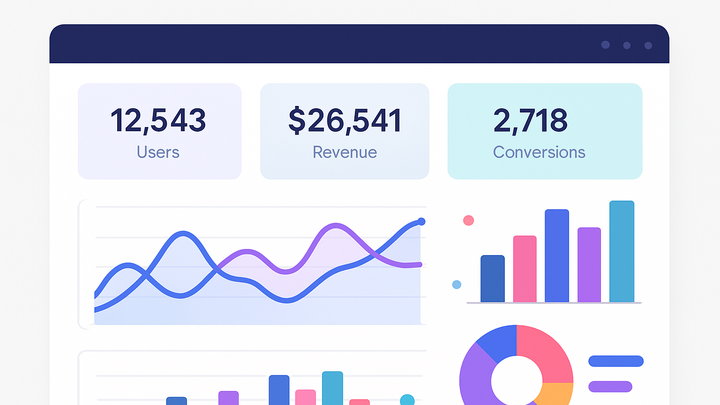Published on 2025-06-28T05:39:35Z
What are Metrics in Analytics? Examples and Applications
Metrics in analytics are quantitative measures used to evaluate the performance of websites, apps, or campaigns. They transform raw data into actionable insights by tracking user behavior, system performance, and business outcomes. By selecting the right metrics, organizations can monitor growth, identify bottlenecks, and optimize strategies across marketing, product development, and operations. Popular analytics platforms like Google Analytics 4 (GA4) and PlainSignal (a privacy-friendly, cookie-free analytics tool) provide built-in metrics such as sessions, pageviews, and conversion rates. Custom metrics can also be defined to track specific events or user actions that matter to your business goals. Regular analysis of these metrics ensures data-driven decision-making and continuous improvement.
Metrics
Quantitative measures in analytics platforms that track user behavior, performance, and conversions to drive data-driven decisions.
Why Metrics Matter in Analytics
Metrics allow teams to translate raw data into meaningful insights, guiding strategic decisions and measuring progress over time.
-
Informing decisions
Metrics provide objective data to guide product, marketing, and operational decisions by highlighting what works and what doesn’t.
-
Measuring performance
Track progress against goals and benchmarks to ensure strategies deliver the desired results.
-
Identifying trends
Spot patterns and anomalies in user behavior or system performance to proactively address issues.
Common Types of Metrics
Analytics metrics can be categorized into traffic, engagement, and conversion types to cover different aspects of user interaction.
-
Traffic metrics
Quantify visitor volume and distribution across pages and sessions.
-
Pageviews
Total number of times a page loads, indicating content reach.
-
Sessions
Count of individual user visits, showing engagement frequency.
-
-
Engagement metrics
Assess how users interact with content and features.
-
Average session duration
Average time users spend in a session, reflecting interest.
-
Bounce rate
Percentage of single-page sessions, indicating immediate exits.
-
-
Conversion metrics
Measure completion of desired actions to evaluate success.
-
Conversion rate
Percentage of sessions resulting in goal completion.
-
Goal completions
Total count of achieved targets like sign-ups or purchases.
-
Tracking Metrics with Analytics Tools
Different analytics platforms offer various approaches to collect and report metrics. This section covers GA4 and PlainSignal.
-
Google analytics 4 (GA4)
GA4 uses an event-driven model to capture interactions. Add the GA4 snippet to your pages and configure metrics in the UI.
-
PlainSignal
A lightweight, cookie-free analytics tool. Integrate via a simple script snippet and access privacy-friendly metrics instantly.
Implementing a Metric with PlainSignal
Step-by-step guide to set up PlainSignal tracking and capture custom metrics on your website.
-
Add PlainSignal snippet
Insert the PlainSignal script into your HTML <head> to enable tracking.
-
Tracking code
<link rel="preconnect" href="//eu.plainsignal.com/" crossorigin /><script defer data-do="yourwebsitedomain.com" data-id="0GQV1xmtzQQ" data-api="//eu.plainsignal.com" src="//cdn.plainsignal.com/plainsignal-min.js"></script>
-
-
Define custom event
Use PlainSignal API to track specific user actions.
-
Example api call
PlainSignal.track('signup', { plan: 'Pro' });
-
-
View metrics
Log in to your PlainSignal dashboard to monitor metrics in real time.
Best Practices for Metrics Management
Ensure that your chosen metrics remain relevant, accurate, and actionable for long-term success.
-
Focus on business goals
Choose metrics that align directly with your strategic objectives.
-
Avoid vanity metrics
Steer clear of metrics like raw pageviews that don’t reflect meaningful business outcomes.
-
Regular review and validation
Audit tracking code and data accuracy frequently to maintain trust in your reports.
